SCI Publications
2012
V. Pascucci, G. Scorzelli, B. Summa, P.-T. Bremer, A. Gyulassy, C. Christensen, S. Philip, S. Kumar.
“The ViSUS Visualization Framework,” In High Performance Visualization: Enabling Extreme-Scale Scientific Insight, Chapman and Hall/CRC Computational Science, Ch. 19, Edited by E. Wes Bethel and Hank Childs (LBNL) and Charles Hansen (UofU), Chapman and Hall/CRC, 2012.

2011
T. Peterka, R. Ross, A. Gyulassy, V. Pascucci, W. Kendall, H.-W. Shen, T.-Y. Lee, A. Chaudhuri.
“Scalable Parallel Building Blocks for Custom Data Analysis,” In Proceedings of the 2011 IEEE Symposium on Large-Scale Data Analysis and Visualization (LDAV), pp. 105--112. October, 2011.
DOI: 10.1109/LDAV.2011.6092324
We present a set of building blocks that provide scalable data movement capability to computational scientists and visualization researchers for writing their own parallel analysis. The set includes scalable tools for domain decomposition, process assignment, parallel I/O, global reduction, and local neighborhood communicationtasks that are common across many analysis applications. The global reduction is performed with a new algorithm, described in this paper, that efficiently merges blocks of analysis results into a smaller number of larger blocks. The merging is configurable in the number of blocks that are reduced in each round, the number of rounds, and the total number of resulting blocks. We highlight the use of our library in two analysis applications: parallel streamline generation and parallel Morse-Smale topological analysis. The first case uses an existing local neighborhood communication algorithm, whereas the latter uses the new merge algorithm.
D. Thompson, J.A. Levine, J.C. Bennett, P.-T. Bremer, A. Gyulassy, V. Pascucci, P.P. Pebay.
“Analysis of Large-Scale Scalar Data Using Hixels,” In Proceedings of the 2011 IEEE Symposium on Large-Scale Data Analysis and Visualization (LDAV), Providence, RI, pp. 23--30. 2011.
DOI: 10.1109/LDAV.2011.6092313
2009
J. Tierny, A. Gyulassy, E. Simon, V. Pascucci.
“Loop Surgery for Volumetric Meshes: Reeb Graphs Reduced to Contour Trees,” In IEEE Transactions on Visualization and Computer Graphics, Proceedings of the 2009 IEEE Visualization Conference, Vol. 15, No. 6, pp. 1177--1184. Sept/Oct, 2009.
DOI: 10.1109/TVCG.2009.163
2007
P.-T. Bremer, E.M. Bringa, M.A. Duchaineau, A. Gyulassy, D. Laney, A. Mascarenhas, V. Pascucci.
“Topological Feature Extraction and Tracking,” In Proceedings of SciDAC 2007 -- Scientific Discovery Through Advanced Computing, Boston, MA, USA, Vol. 78, Journal of Physics Conference Series, pp. 012032 (5pp). June, 2007.
A. Gyulassy, V. Natarajan, B. Hamann, V. Pascucci.
“Efficient Computation of Morse-Smale Complexes for Three-dimensional Scalar Functions,” In IEEE Transactions on Visualization and Computer Graphics, Note: (presented at IEEE VIS 2007), 2007.
A. Gyulassy, V. Natarajan, B. Hamann, M. Duchaineau, V. Pascucci, E. Bringa, A. Higginbotham.
“Topologically Clean Distance Fields,” In IEEE Transactions on Visualization and Computer Graphics, Note: (presented at IEEE VIS 2007), 2007.
2006
A. Gyulassy, V. Natarajan, V. Pascucci, P.-T. Bremer, B. Hamann.
“A Topological Approach to Simplification of Three-Dimensional Scalar Functions,” In IEEE Transactions on Visualization and Computer Graphics, Vol. 12, No. 4, pp. 474--484. August, 2006.
2005
A. Gyulassy, V. Natarajan, V. Pascucci, P.-T. Bremer, B. Hamann.
“Topology-based Simplification for Feature Extraction from 3D Scalar Fields,” In Proceedings of the IEEE Conference on Visualization (VIS-05), pp. 275--280. October, 2005.
Page 2 of 2
